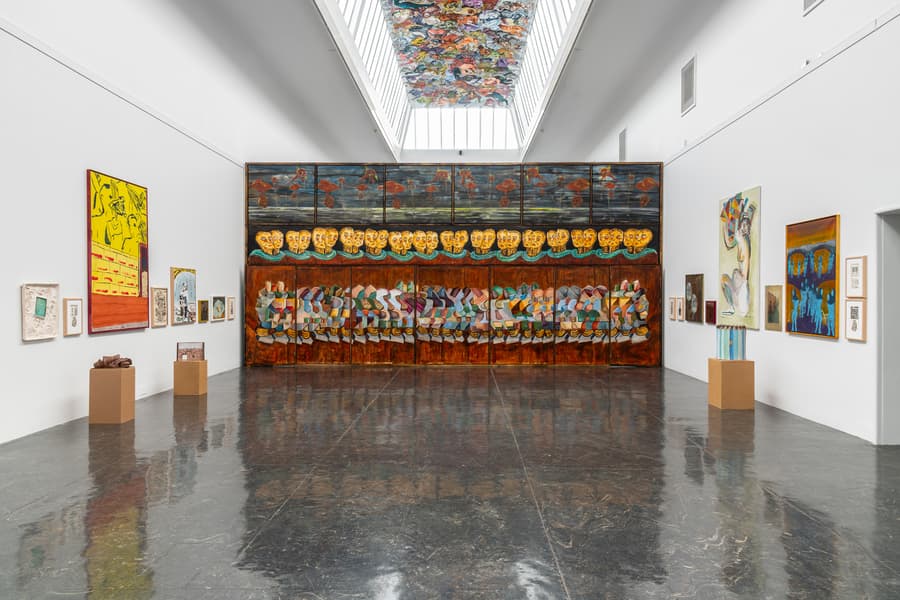Vesttysk kunst på 80-tallet

Catalog text
ABOUT THE EXHIBITION.
It has been fifteen years since the last comprehensive exhibition of West German contemporary art was shown in Norway. The exhibition was shown under the title "40 Germans under 40" in Norway and Finland in 1969/70. As the title promised, the collection presented new tendencies of younger artists; most of them today belong to European, not to mention international, contemporary art. Since that time, art has been characterized by new stylistic movements and tendencies, also by those hostile to art. Much that set the tone at the time, such as Concept art, POP art, OP art, light and movement, has lost some of its topicality. But the Norwegians' view of West German contemporary art has also changed. The artists in "40 Germans under 40" were hardly known to the Norwegian art public at the time and neither public collections nor private enthusiasts were interested in buying anything (something both have since regretted!). The immediate consequences for Norwegian contemporary art were rather small. Today, the situation is completely different.
Interest in German contemporary art has grown steadily both among Norwegian artists and among the country's art historians, museum staff and collectors. One can almost speak of a new orientation. This can be clearly seen in the exhibitions of young Norwegian artists who not only greedily take up the main impulses from continental art trends, but who also work further with certain new tendencies from the Rhein-Ruhr area. This reorientation is also evident at universities and academies; when it comes to choosing artistic landscapes for excursions or scholarships, the Federal Republic has become a favorite travel destination and place of work, alongside New York and the Netherlands. This new interest is also clearly evident in the exhibition programme-
more and sales to public institutions — and just as much in the private galleries' work and offerings. Our concept for the exhibition tries to respond to these changed conditions. Therefore, some important names in West German art such as Joseph Beuys, Horst Janssen and Anselm Kiefer, who have just been represented with solo exhibitions in Norway, are also missing.
This exhibition must also be understood as a response to a collection of Norwegian contemporary art that was shown in Kieler week 1981 in the Kunsthallen Zu Kiel and afterwards in Darmstadt's Art Association. During the preparations for the exhibition planned by a working group in Norway (with art historians Trygve Negaard and Gerd Woll in Oslo, with professor of form and color Jan Brockmann in Trondheim and with the director of Kunsthalle zu Kiel, Jens Christian Jensen) close contacts arose and an atmosphere of friendly cooperation that could be made fruitful for this exhibition. Each of the three of us — Jan Brockmann from Trondheim, Kjell Nupen from Kristiansand and Jens Christian Jensen from Kiel — has been able to contribute their assessments. We hope that in this way we have not given in to unreflected likes and dislikes — at any rate we had no difficulty in agreeing, and each of us has renounced certain wishes without grumbling.
When choosing and ordering the Norwegian exhibition locations, it was a co-determining idea to take regionalism in the official cultural policy seriously: the exhibition does not start in the country's current capital, but in the medieval one. For cultural workers in this elongated country, it is of crucial importance that initiatives and concepts that go beyond the region's borders are not, of course, captured and taken care of by the capital Oslo. Kunstnernes Hus in Oslo has backed this idea. The exhibition has been restored following an initiative by the board of Trondhjem's Art Association with its chairman Eilif Olsen as the driving force. When there was a similar wish at Kunstnernes Hus in Oslo, it was natural to join forces to realize this project. The Department of Culture in the Ministry of Foreign Affairs of the Federal Republic of Germany has kindly supported this exhibition. Thus, a significant part of the foundation was created from the German side. - We thank you for this support. To our delight, the exhibition can now also be shown in Denmark, in the Aarhus Art Museum. We thank the Royal Danish Ministry for Cultural Affairs and the museum's director, Liese Funder, for their commitment and help. We thank Magni Gjelsvik for a large part of the difficult work with the translation, as well as Ruth Waadeland, Svein Christiansen and Gunnar Osen who have sacrificed part of their holidays to proofread. Despite our joint efforts, there will certainly be enough comprehension difficulties left for the Norwegian reader, i.e. enough work with the texts. It became visible during this work that the Norwegian and German way of writing about art is clearly different. Seen through Norwegian eyes, German art writers are all too often philosophically abstract. Much remains obscure for the Norwegian reader who expects pragmatic hints and realizations that are gained as concretely as possible in a direct visual experience of the work. We hope that we have not been too unfair, neither to any of the German authors nor to the Norwegian and Danish readers.


